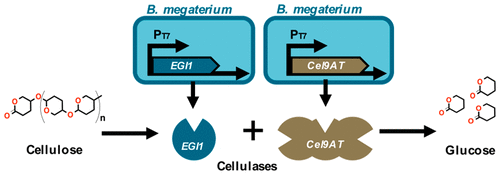当前位置:
X-MOL 学术
›
ACS Synth. Biol.
›
论文详情
Our official English website, www.x-mol.net, welcomes your
feedback! (Note: you will need to create a separate account there.)
Engineering Bacillus megaterium Strains To Secrete Cellulases for Synergistic Cellulose Degradation in a Microbial Community
ACS Synthetic Biology ( IF 3.7 ) Pub Date : 2018-09-18 00:00:00 , DOI: 10.1021/acssynbio.8b00186 Karolina Z. Kalbarczyk 1 , Emily J. Mazeau 1 , Kent M. Rapp 1 , Nicholas Marchand 1 , Mattheos A. G. Koffas 1 , Cynthia H. Collins 1
ACS Synthetic Biology ( IF 3.7 ) Pub Date : 2018-09-18 00:00:00 , DOI: 10.1021/acssynbio.8b00186 Karolina Z. Kalbarczyk 1 , Emily J. Mazeau 1 , Kent M. Rapp 1 , Nicholas Marchand 1 , Mattheos A. G. Koffas 1 , Cynthia H. Collins 1
Affiliation

|
Recent environmental concerns have intensified the need to develop systems to degrade waste biomass for use as an inexpensive carbon source for microbial chemical production. Current approaches to biomass utilization rely on pretreatment processes that include expensive enzymatic purification steps for the requisite cellulases. We aimed to engineer a synthetic microbial community to synergistically degrade cellulose by compartmentalizing the system with multiple specialized Bacillus megaterium strains. EGI1, an endoglucanase, and Cel9AT, a multimodular cellulase, were targeted for secretion from B. megaterium. A small library of signal peptides (SPs) with five amino acid linkers was selected to tag each cellulase for secretion from B. megaterium. Cellulase activity against amorphous cellulose was confirmed through a series of bioassays, and the most active SP constructs were identified as EGI1 with the LipA SP and Cel9AT with the YngK SP. The activity of the optimized cellulase secretion strains was characterized individually and in tandem to assess synergistic cellulolytic activity. The combination of EGI1 and Cel9AT yielded higher activity than either single cellulase. A coculture of EGI1 and Cel9AT secreting B. megaterium strains demonstrated synergistic behavior with higher activity than either monoculture. This cellulose degradation module can be further integrated with bioproduct synthesis modules to build complex systems for the production of high value molecules.
中文翻译:

工程化巨大芽孢杆菌菌株以分泌纤维素酶在微生物群落中的协同纤维素降解。
最近对环境的关注加剧了对开发降解废物生物质以用作微生物化学生产的廉价碳源的系统的需求。当前生物质利用的方法依赖于预处理过程,该预处理过程包括用于必需纤维素酶的昂贵的酶促纯化步骤。我们的目标是设计一个合成的微生物群落,通过将系统与多个特化的巨大芽孢杆菌菌株区分开来协同降解纤维素。EGI1(一种内切葡聚糖酶)和Cel9AT(一种多模数纤维素酶)的目标是从巨大芽孢杆菌中分泌。选择了一个带有五个氨基酸接头的信号肽(SPs)小文库,以标记每种纤维素酶以从巨大芽孢杆菌中分泌。通过一系列的生物测定证实了针对无定形纤维素的纤维素酶活性,并且最具活性的SP构建物被鉴定为具有LipA SP的EGI1和具有YngK SP的Cel9AT。优化并分别评估了优化的纤维素酶分泌菌株的活性,以评估协同纤维素分解活性。EGI1和Cel9AT的组合产生的活性高于任何一种纤维素酶。分泌巨大芽孢杆菌的EGI1和Cel9AT的共培养显示出比任何一种单培养都具有更高活性的协同行为。该纤维素降解模块可以进一步与生物产品合成模块集成,以构建用于生产高价值分子的复杂系统。
更新日期:2018-09-18
中文翻译:

工程化巨大芽孢杆菌菌株以分泌纤维素酶在微生物群落中的协同纤维素降解。
最近对环境的关注加剧了对开发降解废物生物质以用作微生物化学生产的廉价碳源的系统的需求。当前生物质利用的方法依赖于预处理过程,该预处理过程包括用于必需纤维素酶的昂贵的酶促纯化步骤。我们的目标是设计一个合成的微生物群落,通过将系统与多个特化的巨大芽孢杆菌菌株区分开来协同降解纤维素。EGI1(一种内切葡聚糖酶)和Cel9AT(一种多模数纤维素酶)的目标是从巨大芽孢杆菌中分泌。选择了一个带有五个氨基酸接头的信号肽(SPs)小文库,以标记每种纤维素酶以从巨大芽孢杆菌中分泌。通过一系列的生物测定证实了针对无定形纤维素的纤维素酶活性,并且最具活性的SP构建物被鉴定为具有LipA SP的EGI1和具有YngK SP的Cel9AT。优化并分别评估了优化的纤维素酶分泌菌株的活性,以评估协同纤维素分解活性。EGI1和Cel9AT的组合产生的活性高于任何一种纤维素酶。分泌巨大芽孢杆菌的EGI1和Cel9AT的共培养显示出比任何一种单培养都具有更高活性的协同行为。该纤维素降解模块可以进一步与生物产品合成模块集成,以构建用于生产高价值分子的复杂系统。











































 京公网安备 11010802027423号
京公网安备 11010802027423号